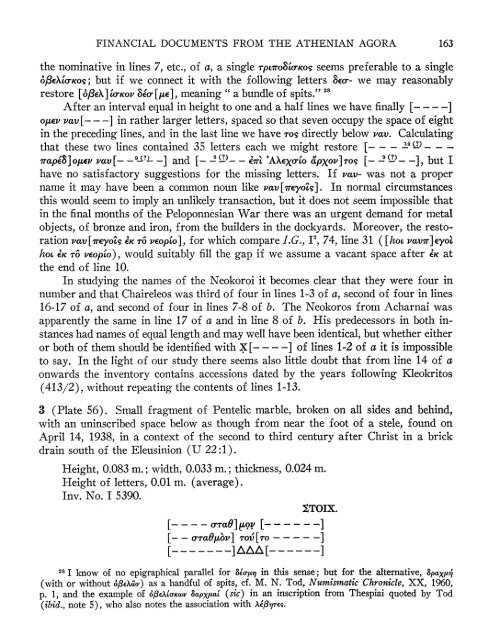(ie, 351/0). - The American School of Classical Studies at Athens
(ie, 351/0). - The American School of Classical Studies at Athens
(ie, 351/0). - The American School of Classical Studies at Athens
You also want an ePaper? Increase the reach of your titles
YUMPU automatically turns print PDFs into web optimized ePapers that Google loves.
FINANCIAL DOCUMENTS FROM THE ATHENIAN AGORA 163<br />
the nomin<strong>at</strong>ive in lines 7, etc., <strong>of</strong> a, a single TpiarO oKOS seems preferable to a single<br />
oJ3eXurKoq; but if we connect it with the following letters &Eo- we may reasonably<br />
restore [o/,eX] UTKov 8& [,e], meaning " a bundle <strong>of</strong> spits." 28<br />
After an interval equal in height to one and a half lines we have finally [- -- -]<br />
opev vav[-- -] in r<strong>at</strong>her larger letters, spaced so th<strong>at</strong> seven occupy the space <strong>of</strong> eight<br />
in the preceding lines, and in the last line we have rog directly below vav. Calcul<strong>at</strong>ing<br />
th<strong>at</strong> these two lines contained 35 letters each we might restore [- - 14()-<br />
__ 8 ~~~[_ (I7) " ,<br />
1 ,i\E(_<br />
,<br />
oapeOj?v vav[ - - ] and [? ?&- -9C=)--],butI 'AXEXO OpXov]Os [-<br />
have no s<strong>at</strong>isfactory suggestions for the missing letters. If vav- was not a proper<br />
name it may have been a common noun like vav [lreyoZS]. In normal circumstances<br />
this would seem to imply an unlikely transaction, but it does not seem impossible th<strong>at</strong><br />
in the final months <strong>of</strong> the Peloponnesian War there was an urgent demand for metal<br />
objects, <strong>of</strong> bronze and iron, from the builders in the dockyards. Moreover, the restor<strong>at</strong>ion<br />
vav [ireyos eK Tor vEopio], for which compare I.G., P2, 74, line 31 ([hot vavir] Eyol<br />
hot EK TO VEOptO), would suitably fill the gap if we assume a vacant space after EK <strong>at</strong><br />
the end <strong>of</strong> line 10.<br />
In studying the names <strong>of</strong> the Neokoroi it becomes clear th<strong>at</strong> they were four in<br />
number and th<strong>at</strong> Chaireleos was third <strong>of</strong> four in lines 1-3 <strong>of</strong> a, second <strong>of</strong> four in lines<br />
16-17 <strong>of</strong> a, and second <strong>of</strong> four in lines 7-8 <strong>of</strong> b. <strong>The</strong> Neokoros from Acharnai was<br />
apparently the same in line 17 <strong>of</strong> a and in line 8 <strong>of</strong> b. His predecessors in both instances<br />
had names <strong>of</strong> equal length and may well have been identical, but whether either<br />
or both <strong>of</strong> them should be identif<strong>ie</strong>d with X[ ] <strong>of</strong> lines 1-2 <strong>of</strong> a it is impossible<br />
to say. In the light <strong>of</strong> our study there seems also little doubt th<strong>at</strong> from line 14 <strong>of</strong> a<br />
onwards the inventory contains accessions d<strong>at</strong>ed by the years following Kleokritos<br />
(413/2), without repe<strong>at</strong>ing the contents <strong>of</strong> lines 1-13.<br />
3 (Pl<strong>at</strong>e 56). Small fragment <strong>of</strong> Pentelic marble, broken on all sides and behind,<br />
with an uninscribed space below as though from near the foot <strong>of</strong> a stele, found on<br />
April 14, 1938, in a context <strong>of</strong> the second to third century after Christ in a brick<br />
drain south <strong>of</strong> the Eleusinion (U 22:1).<br />
Height, 0.083 m.; width, 0.033 m.; thickness, 0.024 m.<br />
Height <strong>of</strong> letters, 0.01 m. (average).<br />
Inv. No. I 5390.<br />
VTOIX.<br />
- craGpuov] v ov [ro ? ]<br />
[ -_____ 1AAAr______<br />
28 I know <strong>of</strong> no epigraphical parallel for Ufau in this sense; but for the altern<strong>at</strong>ive, 8paX/p<br />
(with or without 0/eXiXv) as a handful <strong>of</strong> spits, cf. M. N. Tod, Numism<strong>at</strong>ic Chronicle, XX, 1960,<br />
p. 1, and the example <strong>of</strong> o'8eAXcrKwv Sapx/,xa1 (sic) in an inscription from <strong>The</strong>spiai quoted by Tod<br />
(ibid., note 5), who also notes the associ<strong>at</strong>ion with AX,I3TSe.

















